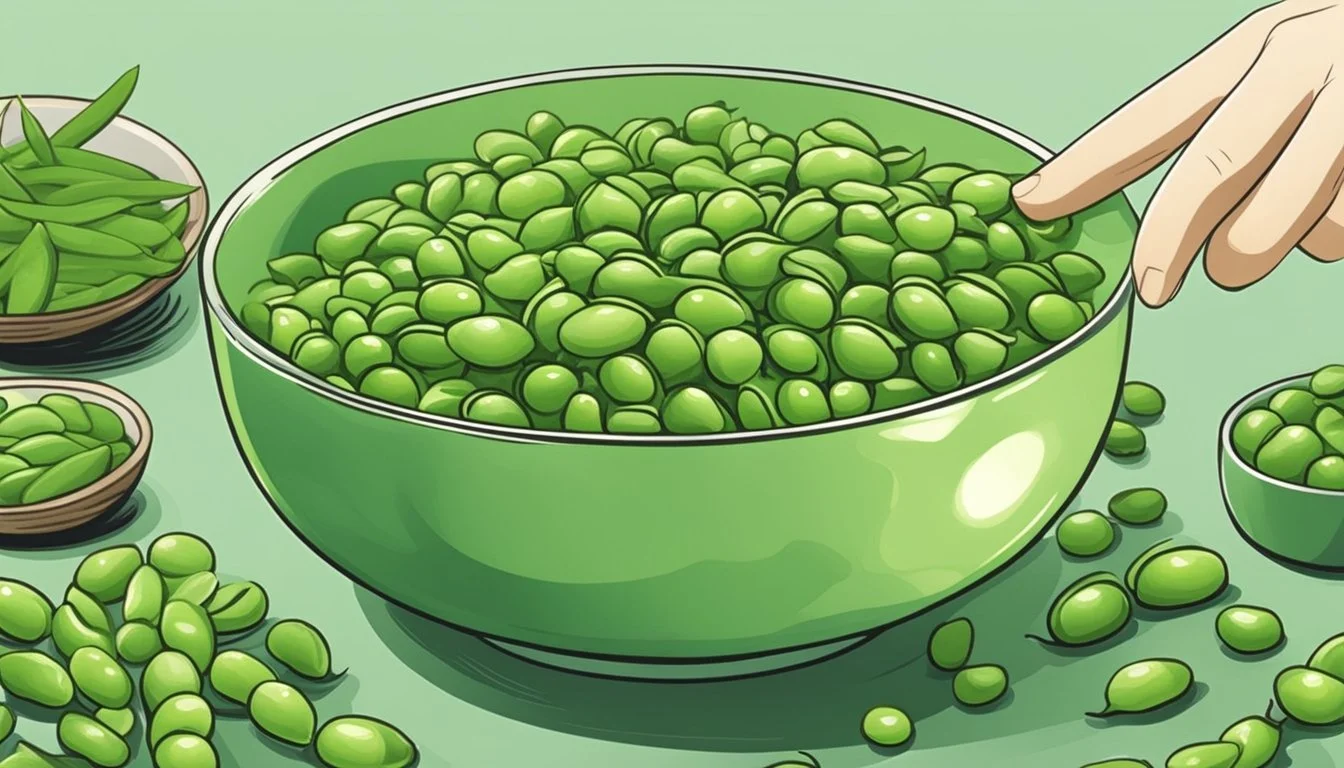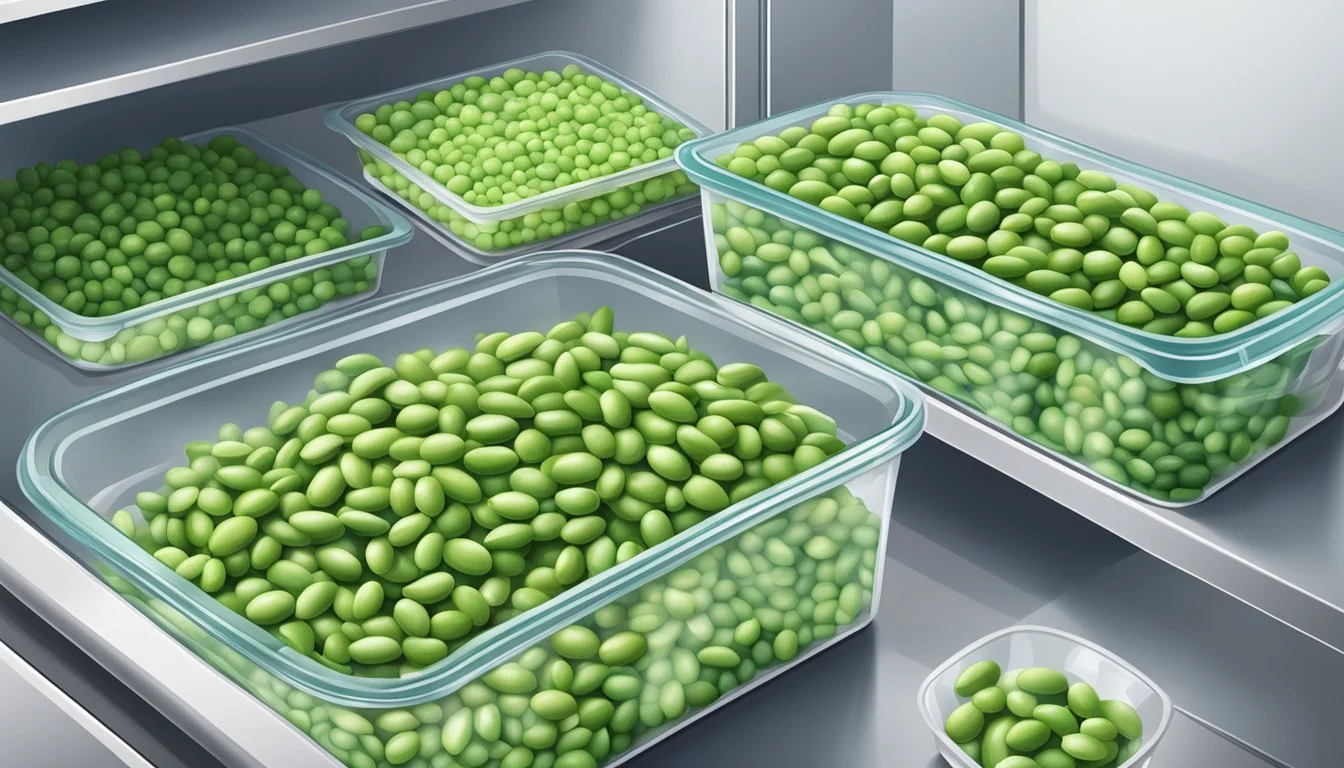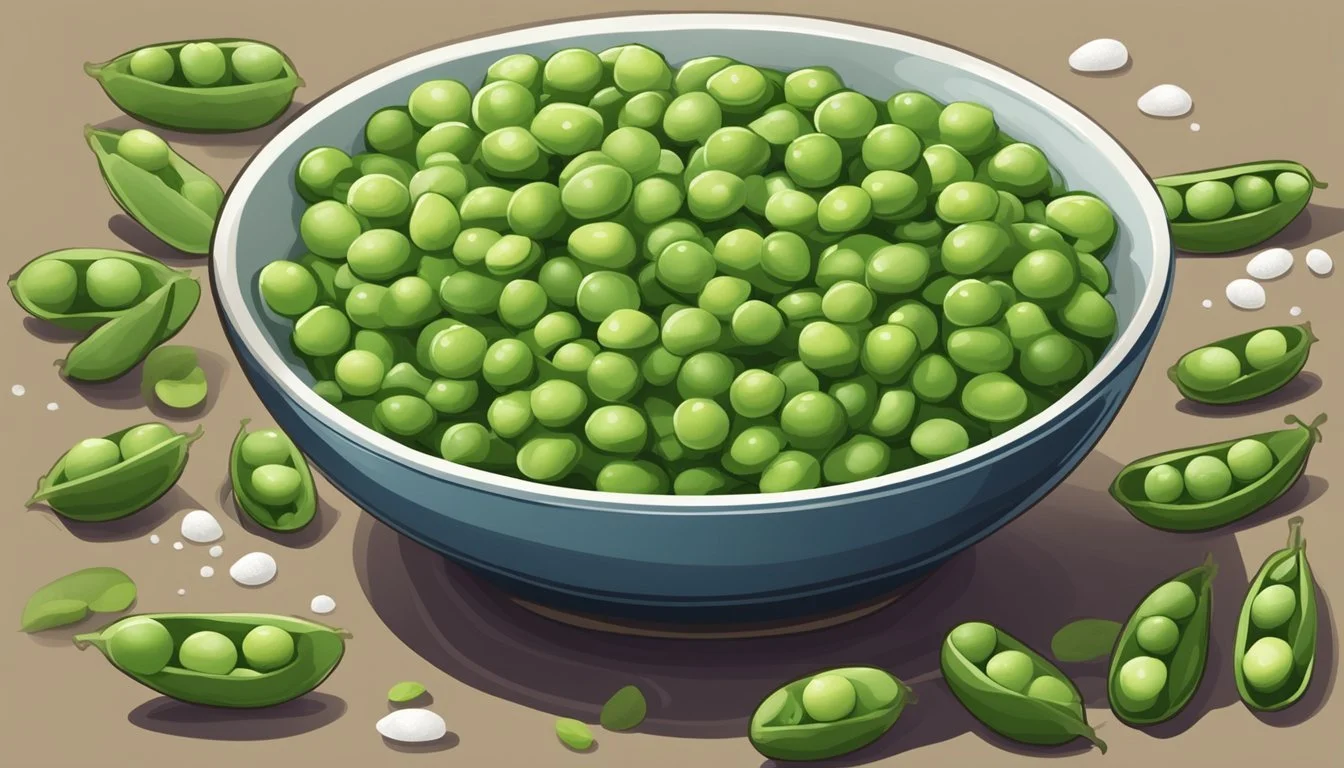Fresh vs. Frozen Edamame: Choosing the Best Option for Flavor and Convenience
Edamame, the vibrant green soybeans popular in Japanese cuisine, offer a delicious and nutritious snack or side dish option. These young soybeans can be found fresh in their pods or conveniently frozen for year-round enjoyment. Both fresh and frozen edamame can be cooked in just 4-5 minutes by boiling or steaming, making them a quick and easy addition to meals.
Fresh edamame provides a crisp texture and slightly sweet flavor when cooked properly. Frozen edamame, while not quite as crisp, retains much of its nutritional value and can be stored for longer periods. Either option delivers a protein-packed punch, with one cup of cooked edamame containing an impressive 31 grams of complete protein.
Preparing edamame is simple and versatile. They can be served warm or cold, seasoned with salt or other spices, and incorporated into various dishes. Whether enjoyed as a standalone snack or added to salads, stir-fries, or grain bowls, edamame offers a tasty way to boost the nutritional content of meals.
Understanding Edamame
Edamame, a popular legume, offers versatile culinary applications and notable nutritional benefits. This protein-rich food can be found in both fresh and frozen forms, each with distinct characteristics and uses.
What Is Edamame?
Edamame refers to immature soybeans still in their pods. These bright green beans are typically harvested before they harden. Edamame has a slightly sweet, nutty flavor and a firm texture.
The pods are not edible but serve as a convenient vessel for cooking and eating the beans. To consume edamame, people often squeeze the pods to pop out the soft, edible beans inside.
Edamame is commonly served as an appetizer in Japanese cuisine but has gained popularity worldwide as a healthy snack and ingredient in various dishes.
Comparing Fresh vs. Frozen Edamame
Fresh edamame has a short shelf life and is typically available seasonally. It offers the best flavor and texture but requires prompt use or proper storage.
Frozen edamame is more widely available and convenient. It retains most of its nutritional value and can be stored for several months.
Fresh edamame:
Best flavor and texture
Short shelf life
Requires quick preparation
Frozen edamame:
Longer shelf life
Convenient and readily available
Maintains nutritional value
Both forms can be boiled, steamed, or microwaved. Cooking times may vary slightly between fresh and frozen varieties.
Nutritional Profile of Edamame
Edamame is a nutrient-dense food, packed with essential vitamins and minerals. It is an excellent source of plant-based protein, making it popular among vegetarians and vegans.
Key nutrients in edamame:
Protein: 8g per 1/2 cup serving
Fiber: 4g per 1/2 cup serving
Iron: 10% of daily value
Calcium: 4% of daily value
Folate: 10% of daily value
Edamame is low in calories and contains no cholesterol. It provides all nine essential amino acids, making it a complete protein source.
The green soybeans are also rich in antioxidants and contain beneficial compounds like isoflavones, which may contribute to heart health and bone strength.
Selecting Your Edamame
Choosing high-quality edamame is crucial for a delicious and nutritious experience. The selection process differs slightly between fresh and frozen options, but both can provide excellent results when prepared properly.
Choosing Fresh Edamame at Farmers Markets
Fresh edamame pods at farmers markets offer peak flavor and texture. Look for bright green, plump pods that feel firm to the touch. Avoid yellowing or wilted pods, as these indicate age or improper storage.
The pods should be slightly fuzzy and have a crisp snap when bent. Check for any signs of damage or discoloration. Fresh edamame is typically sold still attached to the stalk, which helps maintain freshness.
Purchase only what you plan to use within a few days, as fresh edamame has a limited shelf life. If possible, taste a sample to ensure the beans inside are sweet and tender.
Finding Frozen Edamame in the Freezer Aisle
Frozen edamame is a convenient year-round option. In the freezer aisle, look for bags of edamame that are free from ice crystals or clumping, which can indicate thawing and refreezing.
Choose packages labeled as "flash-frozen" or "individually quick frozen" for the best quality. These methods preserve the beans' texture and nutritional value. Check the expiration date and select the freshest option available.
Some brands offer pre-shelled edamame, while others sell whole pods. Consider your intended use when selecting. Pre-shelled beans are convenient for recipes, while pods are ideal for snacking.
Organic options are available for those seeking to avoid pesticides. Compare brands to find the best balance of quality and price for your needs.
Preparation Techniques for Edamame
Proper preparation of edamame ensures optimal flavor and texture. These techniques apply to both fresh and frozen varieties, focusing on washing, trimming, and defrosting as needed.
Washing and Trimming Edamame Pods
Fresh edamame pods require thorough cleaning before cooking. Rinse the pods under cool running water, gently rubbing to remove any dirt or debris. For extra cleanliness, soak the pods in a bowl of cold water for 5-10 minutes, then rinse again.
Inspect each pod for any discoloration or damage. Trim off the stem ends if still attached, using kitchen shears or a sharp knife. This step improves the pods' appearance and makes them easier to eat.
For maximum freshness, pat the washed pods dry with a clean kitchen towel or paper towels. This prevents excess water from diluting the cooking liquid or causing splattering during preparation.
Defrosting Frozen Edamame
Frozen edamame offers convenience and year-round availability. To defrost, place the frozen pods in a colander and run cool water over them for 2-3 minutes. Alternatively, transfer the frozen edamame to a microwave-safe bowl and defrost on 50% power in 30-second intervals, stirring between each interval.
For recipes requiring thawed edamame, place the frozen pods in the refrigerator overnight. This gentle method preserves texture and flavor.
If cooking frozen edamame directly, skip defrosting. Add the frozen pods to boiling water or a steamer basket. Increase cooking time by 1-2 minutes compared to fresh edamame to ensure they're heated through.
Methods of Cooking Edamame
Edamame can be prepared using several simple cooking techniques. Each method offers a unique way to bring out the best flavors and textures of these nutritious soybeans.
Boiling Edamame in Water
Fill a pot with water and add a pinch of salt. Bring the water to a rolling boil over high heat. Add the edamame pods and cook for 4-5 minutes until tender.
For frozen edamame, add them directly to the boiling water without thawing first. Cook for 5-7 minutes or until heated through.
Drain the cooked edamame in a colander. For a chilled dish, rinse under cold water to stop the cooking process. Season with additional salt if desired.
Steaming Edamame to Preserve Flavor
Place a steamer basket in a pot with about an inch of water. Ensure the water doesn't touch the bottom of the basket. Bring the water to a boil over high heat.
Add the edamame pods to the steamer basket and sprinkle with salt. Cover the pot and steam for 5-7 minutes until the pods are tender.
Remove the steamer basket from the pot. Allow the edamame to cool slightly before serving. Steaming helps retain more nutrients compared to boiling.
Microwaving for Quick Convenience
Place edamame pods in a microwave-safe dish. Add 2-3 tablespoons of water and cover the dish.
Microwave on high for 2-3 minutes for fresh edamame, or 3-4 minutes for frozen. Stir halfway through cooking to ensure even heating.
Let the edamame stand for 1 minute after microwaving. Carefully remove the cover, as hot steam will escape. Season with salt and serve.
Microwaving is the fastest method but may result in slightly less even cooking compared to boiling or steaming.
Seasoning and Serving Edamame
Edamame's versatility shines through various seasoning options and serving styles. From simple salt to complex flavor combinations, these green soybeans adapt well to different culinary applications.
Classic Seasoning with Salt and Sesame Oil
Salt remains the most popular seasoning for edamame. After cooking, sprinkle sea salt or kosher salt over the pods. For added depth, drizzle toasted sesame oil and toss gently. Garlic lovers can grate a clove over the warm beans for an aromatic twist.
Some enjoy a light soy sauce coating instead of salt. Mix soy sauce with a touch of rice vinegar and brush over the pods. For a spicy kick, add red pepper flakes or a dash of sriracha sauce.
Experiment with different seasoning blends. Try a mixture of salt, black pepper, and lemon zest. Or create an Asian-inspired blend with five-spice powder and a pinch of sugar.
Incorporating Edamame into Salads and Side Dishes
Edamame adds protein and a pop of color to salads. Toss shelled beans with mixed greens, cherry tomatoes, and a light vinaigrette. For a heartier option, combine edamame with quinoa, diced cucumbers, and feta cheese.
Create a simple side dish by mixing edamame with corn kernels and diced bell peppers. Season with lime juice and chili powder for a Mexican-inspired flavor profile.
For a warm side, sauté shelled edamame with sliced mushrooms and minced ginger. Finish with a splash of soy sauce and a sprinkle of sesame seeds.
Creative Recipes for Edamame-Based Dishes
Transform edamame into a creamy dip. Blend shelled beans with tahini, lemon juice, and olive oil for a protein-rich alternative to hummus. Serve with vegetable sticks or pita chips.
Make edamame fried rice by stir-frying cooked rice with shelled edamame, scrambled eggs, and diced carrots. Season with soy sauce and sesame oil for a quick, nutritious meal.
For a unique appetizer, prepare edamame fritters. Mix mashed edamame with breadcrumbs, egg, and herbs. Form into small patties and pan-fry until golden brown. Serve with a yogurt-based dipping sauce.
Create a refreshing summer soup by blending edamame with cucumber, avocado, and vegetable broth. Chill and garnish with a swirl of cream and fresh herbs before serving.
Edamame in Various Cuisines
Edamame has found its way into diverse culinary traditions, adapting to different flavor profiles and cooking methods. Its versatility allows it to shine in both traditional Asian dishes and modern Western cuisine.
Traditional Japanese Uses of Edamame
In Japan, edamame is a beloved appetizer and snack. It's commonly served in izakayas (Japanese pubs) as a salty, beer-friendly nibble. Chefs often prepare edamame by boiling the pods in salted water and serving them whole.
Sushi restaurants may incorporate shelled edamame into vegetarian rolls or as a side dish. Many Japanese households enjoy edamame as part of their home-cooked meals.
Rice bowls, known as donburi, sometimes feature edamame as a nutritious topping. The beans add color, texture, and protein to these popular one-dish meals.
Incorporating Edamame in Western Dishes
Western cuisines have embraced edamame as a versatile ingredient. Chefs and home cooks use it to boost the nutritional value of various dishes.
Edamame often appears in salads, adding a fresh, green element and protein boost. It pairs well with grains like quinoa or couscous in cold salads.
Stir-fries benefit from the addition of edamame, which maintains its texture and adds a pop of color. The beans can replace or complement other green vegetables in these dishes.
Some cooks use edamame to create unique dips or spreads, similar to hummus. These offer a protein-rich alternative to traditional appetizers.
Fried rice dishes may include edamame for added nutrition and flavor. The beans integrate well with other vegetables and proteins in these popular dishes.
Health Benefits and Dietary Considerations
Edamame offers numerous nutritional advantages and fits well into various diets. Its versatility and nutrient profile make it a valuable addition to many eating patterns.
Edamame as a Source of Plant-Based Protein
Edamame provides a complete protein source, containing all nine essential amino acids. A half-cup serving offers about 8 grams of protein.
This makes edamame an excellent option for those looking to increase their plant-based protein intake. It's particularly beneficial for athletes, active individuals, and those following plant-based diets.
Edamame's protein content supports muscle growth and repair. It also aids in maintaining healthy bones, skin, and organs.
The Role of Edamame in Vegetarian and Vegan Diets
Edamame serves as a versatile ingredient in vegetarian and vegan meal planning. It can be incorporated into salads, stir-fries, or eaten as a snack.
For those avoiding animal products, edamame helps meet protein requirements. It also provides essential nutrients often lacking in plant-based diets, such as iron and calcium.
Edamame's nutrient density makes it an ideal meat substitute in many recipes. Its mild flavor allows for easy incorporation into various dishes without overpowering other ingredients.
Potential Health Benefits Related to Edamame Consumption
Regular edamame consumption may contribute to several health benefits. Its high fiber content supports digestive health and helps maintain stable blood sugar levels.
Edamame contains isoflavones, which may have protective effects against certain cancers. These compounds also show potential in reducing menopausal symptoms in women.
The folate in edamame supports fetal development during pregnancy. Its calcium content contributes to bone health, while its iron helps prevent anemia.
Edamame's low glycemic index makes it suitable for diabetes management. Its heart-healthy fats may also aid in reducing cardiovascular disease risk.
Storing Edamame for Freshness
Proper storage is crucial for maintaining the quality and flavor of edamame. The method depends on whether you have fresh or frozen edamame, with each requiring specific conditions to preserve freshness.
Proper Storage of Fresh Edamame
Fresh edamame should be stored in the refrigerator at temperatures between 32°F and 38°F (0°C to 3.3°C). Place the pods in a perforated plastic bag to allow air circulation. This helps prevent moisture buildup and keeps the edamame fresh for 7-10 days.
For optimal freshness, store edamame in the crisper drawer of the refrigerator. This area provides the ideal cool and dry environment needed to maintain quality.
If you plan to consume the edamame within 2-3 days, you can keep them in a cool, dry place outside the refrigerator. However, refrigeration is recommended for longer storage periods.
Keeping Frozen Edamame at Optimal Quality
Frozen edamame should be stored in the freezer at 0°F (-18°C) or below. Keep the pods in their original packaging or transfer them to an airtight container to prevent freezer burn.
When properly stored, frozen edamame can maintain its quality for up to 12 months. To thaw, transfer the desired amount to the refrigerator overnight or use the microwave for quick defrosting.
For best results, blanch fresh edamame before freezing. This process involves briefly boiling the pods, then immediately cooling them in ice water. Blanching helps preserve color, texture, and nutritional value during long-term freezer storage.
A Guide to Frequently Used Edamame Terminology
Edamame pods refer to the whole soybean pods that contain the edible beans inside. These green pods are typically served as an appetizer or snack.
Shelled edamame are the individual soybeans that have been removed from their pods. They are often used in salads, stir-fries, and other dishes.
Boiled edamame is a common preparation method. The pods are briefly cooked in salted water until tender, usually for 3-5 minutes.
Steamed edamame is another popular cooking technique. The pods are placed in a steamer basket over boiling water for about 5-7 minutes.
Plant-based protein describes edamame's nutritional profile, as it's a rich source of protein derived from soybeans.
Charred edamame refers to a cooking style where the pods are lightly grilled or pan-seared for a smoky flavor.
Frozen shelled edamame are pre-shelled soybeans that are frozen for convenience and longer shelf life. They can be quickly thawed and added to various dishes.
Table: Common Edamame Preparations
Method Description Boiled Cooked in salted water Steamed Cooked using steam Charred Grilled or pan-seared






